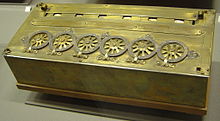Pascaline
The Pascaline is a mechanical calculating machine that was invented by Blaise Pascal in 1642 . For a long time it was considered to be the very first mechanical calculating machine, until documents were found in the 20th century that showed that Wilhelm Schickard had constructed a calculating machine in the 1620s.
Pascal's invention was first called machine d'arithmétique in French , then roue pascaline (“Pascal's wheel”) and finally pascaline .
Pascal started working on his adding machine when he was 19 years old and designed it to make work easier for his father, who was a tax officer. It was made of brass, ivory and wood, among other things. In the course of his life, Pascal refined the mechanism again and again and made around 50 versions of the Pascaline.
The Pascaline had metal dials on which the desired numbers could be set. The results appeared in boxes above the dials. The prototype only had a few dials, later versions had a larger number and could expect numbers up to 9,999,999. Direct subtraction was not possible with the Pascaline; the complementary method had to be used ( see also two's complement for the analog in the binary system ).
A Pascaline from around 1650 is in the Mathematical-Physical Salon of the State Art Collections in the Dresden Zwinger . It is the only specimen in a public collection outside of France.
Web links
- Rudolf Taschner: Blaise Pascal: The Thinking Machine (YouTube recording of a lecture by Rudolf Taschner in the mumok stables, November 21, 2012)
- Staatliche Kunstsammlungen Dresden: Video on Pascaline
- eduMedia: Virtual simulation of the Pascaline
Individual evidence
- ↑ The first calculating machine. Retrieved March 13, 2019 .
- ↑ ▷ VIDEO: Masterpieces of Art: Pascaline. In: museum television. June 3, 2016, accessed on March 13, 2019 (German).
